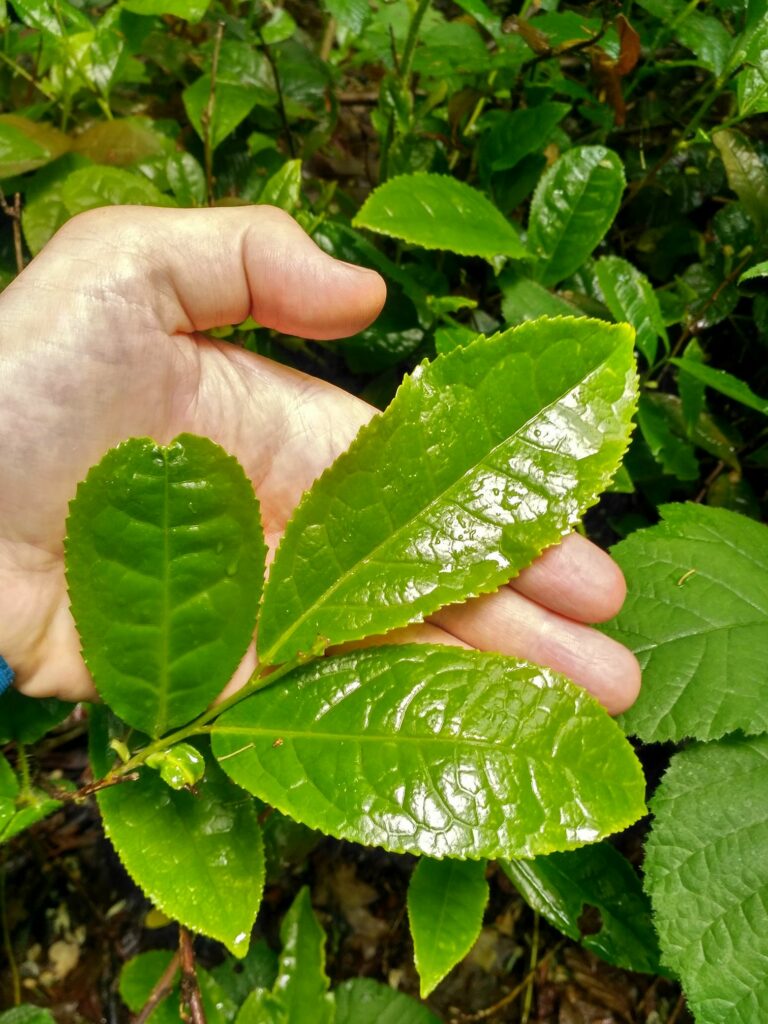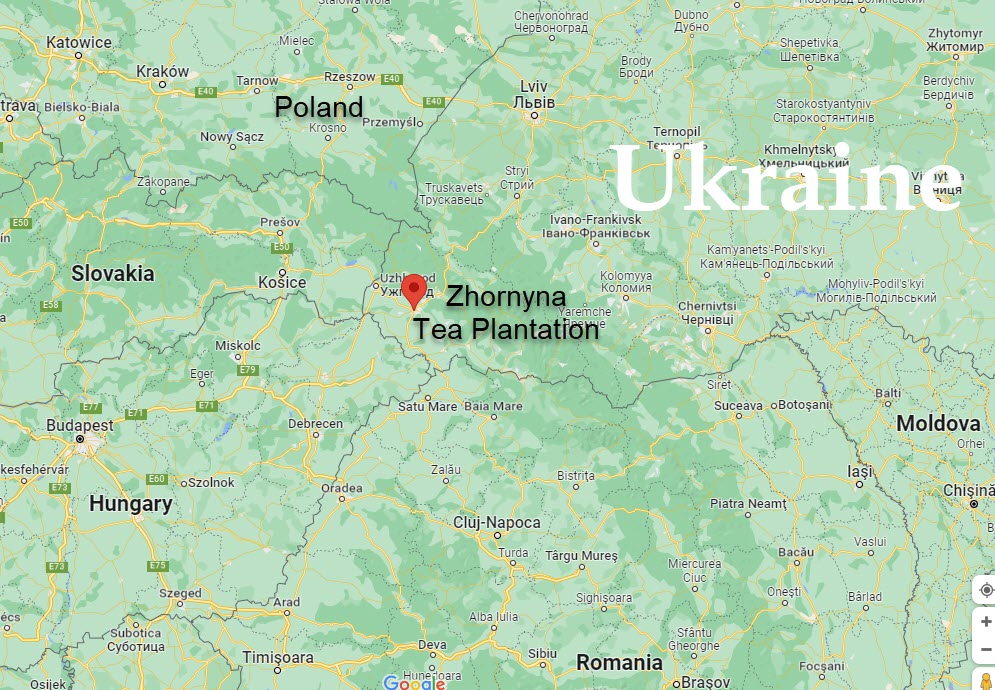Virtually all the world’s tea is grown between the latitudes 20 degrees north and 20 degrees south of the equator. Rising temperatures in this narrow band threaten tea yields and force growers to consider planting “upslope” at higher elevations where cooler temperatures prevail. Unfortunately, subtropical tea cultivars perish in a hard frost, expected above 7,500 feet. The Zhornyna Experimental Tea Plantation in western Ukraine, is located near 50 degrees north latitude. Planter Maksym Malygin is successfully growing tea under forest cover that has survived heavy snow during prolonged winters at temperatures 26 below zero Celsius.
- Caption: Maksym Malygin at his home near Kyiv

Cold-resistant Cultivars are Key to Expanding Tea Lands
By Dan Bolton
The Zhornyna Experimental Tea Plantation is in western Ukraine near Mukachevo, a city of 85,000 located near the borders that Ukraine shares with Hungary, Slovakia, and Poland. Known as the Transcarpathia, this hilly region south of the Carpathian Mountains in ancient times was a part of Kyivan Rus. It was ruled by the Hungarian Empire for 1100 years until World War I and was part of Czechoslovakia until 1945 when it was ceded to Ukraine. The plantation is situated on high ground known as Chervona Hova or the “Red” Mount.
Dan Bolton: Thank you Maxim for joining our podcast. Your first recordings were interrupted by air raid sirens following intense missile attacks near Kyiv where you make your home. What has been the impact of the invasion on Ukraine’s only tea garden?
Maksym Malygin: We planned to carry out classical formative pruning of tea bushes in three seasons, from 2021 to 2023. After the first two years of pruning, we planned to test the winter hardiness of the skeletal branches of the bushes and not cover for the winter. This was planned to be done on 300 bushes that grow on the cleared part of the plantation. Pruning last year showed excellent results, the vegetation of the bushes increased from 15 cm after pruning to 70-80 cm at the end of the season. This April, we planned to cut at a height of 20-25 cm.
We will not do this and lose at least one year. Also, we will not be able to organize the collection of leaves to produce more tea.
“The most ambitious project at the idea stage is the creation of a new two-hectare tea plantation in Ukraine, but right now it’s completely frozen on hold.“
– Maksym Malygin
Dan: It is good to know that you and your family remain safe. I speak for a global tea community that wishes your work will continue without war.
What is the future of Zhornyna as it produces only experimental tea in small batches?
Maksym: We have organized through ways for the development of the Zhornyna project. The first one is gaining experience directly on 300 bushes of the plantation. It’s not possible to make industrial production there, but it’s possible to consistently produce some tea for large tea tastings. The second is the vegetative reproduction of the unique winter-resistant tea. The third is a cooperation with colleagues in Europe on the transfer of tea and growing technologies in harsh climates. The most ambitious project at the idea stage is creation of a new two-hectare tea plantation in Ukraine, but right now it’s completely frozen on hold.
Dan: Listeners in Europe and northern regions that are experimenting with plantings will be interested in your experiments with temperature resistant cultivars. Will you describe the experiment in greater detail?
Maksym: Analyzing cold-weather characteristics and cultivars is an interesting question. And it’s not that easy to answer.
The history of unique Ukrainian tea plantation began in 1949 when non-varietal Georgian and Krasnodar seeds were sown, as well as seeds of the varieties Georgian No. 2, Kangra and a Japanese-Indian hybrid. This is described in the scientific literature.
We made a map of the entire plantation area with the help of the GPS. The total area is 1.4 hectares (about 3.5 acres). Most of the original farm has been destroyed. The surviving tea plants are located in five places. Each has different morphological features. Unfortunately, we still have not been able to find specialists in the post-Soviet years who could establish a tea variety according to the morphological characteristics of plants.
In this case, we need to use DNA analysis, but for comparison, we need to have data from old Soviet cultivars. My personal opinion is that the 300 bushes in the restored area descend from the Georgian No. 2 variety.
During the past 70 years, tea plants on the plantation have experienced snowy winters when the minimum temperature was minus 26 degrees [see map depicting Hardiness Zones, above]. Last winter, the minimum temperature was minus 15 degrees with virtually no snow.
Until 1999 “Zhornyna” was the most northern tea plantation in Europe. After the Tschanara Tea Garden in Germany emerging (the owners are my friends and colleagues Wolfgang Bucher and Haeng ok Kim) “Zhornyna” lost that status, but remains the most frost-resistant culture of tea worldwide (surviving winters with temperatures down to -26 C).
Given the age and adaptation to the local climate, this tea is likely a Ukrainian frost-resistant subpopulation of Georgian tea. It is my opinion.
Related




Seventy-five Years of Experimentation
In 1949 a team from the All-Union research Institute of Tea and Subtropical Agriculture in Georgia, after surveying much of Transcarpathia south of Kyiv, decided that conditions in western Ukraine on Chervona (Red) Hora Mount near the town of Mukachevo were ideal for planting cold-resistant tea.
Dr. I. I. Chkhaidze supervised development of the experimental tea garden which was one of six in the region. The initiatives were part of a greater project of the National Academy of Sciences of the USSR that in 1950 funded attempts to acclimatize tea on territories including Moldova, Transcarpathia, Crimea, Primorsky Krai, and in the far west the islands of South Sakhalin and Kunashir.
At Zhornyna non-varietal Georgian and Krasnodar seeds were sown, as well as seeds of the Georgian No. 2 variety; along with a Kangra cultivar from India and a Japanese-Indian hybrid.
Photos of the plantation taken during the early 50s were lost. “All we can show is one photo from the archive in Russia and three photos from a book written by Dr. Chkhaidze, who led the team of scientists,” writes Zhornyna tea garden owner Maksym Malygin.
The main goal of the project was “…full satisfaction of Soviet people’s needs for domestic tea.” In Georgia the Soviet Union implemented a similar project during the period 1930-1940 that ultimately supplied 30% of tea consumed in the USSR.
Tea was first planted along the Black Sea coastline in 1885 near Batumi. In 1915 there were 170 Georgian tea plantations covering an area of 1,000 ha. By 1932 the state had established 19 state-run tea plantations and nine factories. The area under tea increased to 25,500 ha. By 1993 Georgia growers farming 56,000 ha annually produced 75 million kg of tea at 70 state run factories.
Scientists considered the Transcarpathia to be the second most favorable region next to Georgia for producing tea, said Malygin. Fifty hectares on the collective were developed and 1.5 metric tons of high quality “Chervona Hora” tea was harvested in 1952
The project was canceled in 1953.
After canceling financial support for research, the plantation was abandoned. Lots of tea bushes were dug and cut out, only their roots remained. Thanks to the efforts of plantation workers tea bushes still grow, but there is insufficient capacity to develop the plantation, Malygin explains.
Among the experimental areas established in the Transcarpathian region only Red Mount’s persisted. Fifty years after the original 50 acres (20 hectares) were planted, only two hectares thrived. In 2000 there were several hundred tea plants still growing, blossoming and fructifying, he said. The bushes stood 1.5 meters high, said Malygin.
Tea bushes over generations grew resistant to constant freezes and give new branches in the spring. Skeletal branches do not have time to grow on their own, he explains.
Before 1999 Zhornyna was the most northern tea plantation in Europe. Plantations established in Germany and Great Britain are now the farthest north but Zhornyna is the site of the most frost-resistant tea cultivars worldwide, he said.

“In December 2013, my wife and I visited the plantation for the first time and fell in love with this place. So was started the Zhornyna tea plantation conservation project that we call “Tea Grows in Ukraine.”
The first step was to develop technology for the production of terroir and demonstrate that the leaves could produce quality tea. Experimental developments of semi- and full-fermented teas, were done from 2015 to 2021. The results demonstrated the great potential of the Transcarpathian teas, according to experts’ opinions.
The second stage came in 2019, when part of the plantation was cleared. Our attention was then focused on the 300 small bushes. Shelters were built and the tea plants survived the cold winters.
This block is restricted as a test
Related




Link to share this post with your colleagues
Signup and receive Tea Biz weekly in your inbox.








One response to “Ukraine’s Cold Weather Tea”
Tea is grown in Scotland too, in similar ( but non-war! ) conditions.